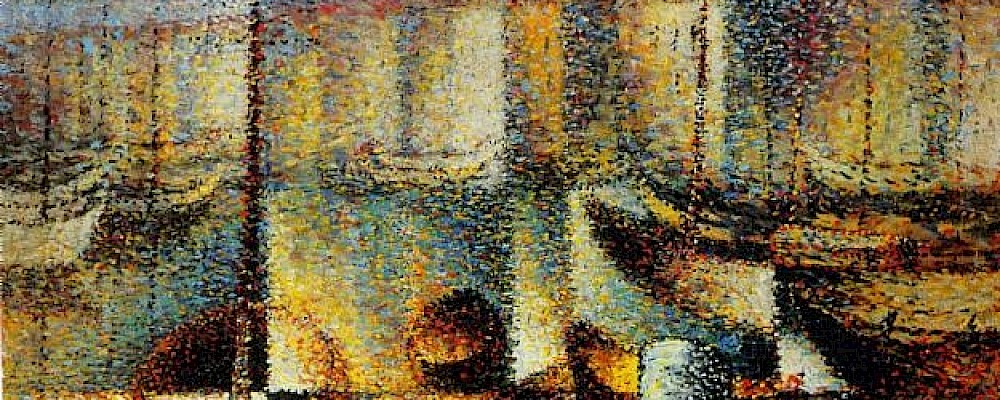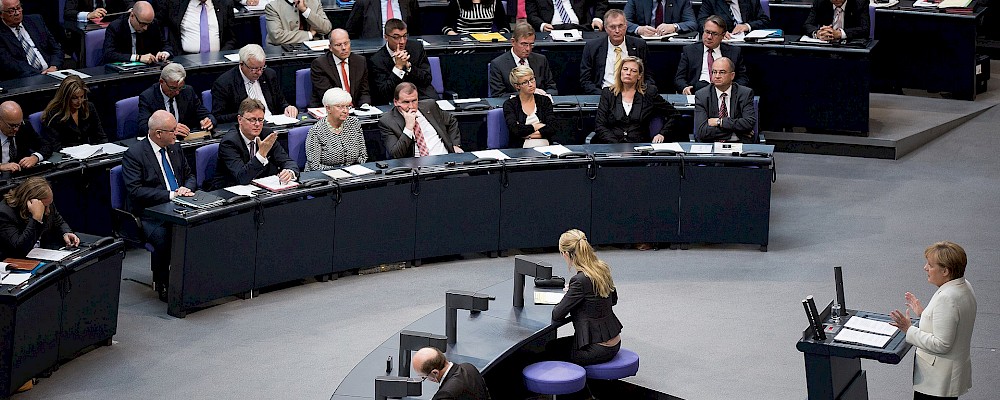A Black Perspective for Germany
In contrast to the title of the book Deutschland Schwarz Weiß, the picture of racism in Germany is not only black and white. In fact, the author Noah Sow reveals the multiple layers of structural racism in Germany and at the same time makes the readers aware of their own behaviour.

A black perspective for Germany
"I originally come from a country whose level of civilization was smiled at by many states in the Western world and was, with interest, looked down from above not so long ago. No wonder: Very close by, for example, there were still tribes who painted (!) and collected the skulls of their deceased children." With those introductory words the author describes the country of her origin. The solution for the question, which underdeveloped country that might be, is so counterintuitive that it is almost evident. It is Germany. Caught with the own euro-centric thoughts on the first pages, it sensitizes the reader for the further reading and their own behaviour to enter more intellectual games.
Thus, Sow neglects the widespread assumption that racism in Germany is outdated at the very beginning and puts the readers themselves on the stage. Once there, they have to face an honest but partly unpleasant firework of words and allegations. The directness of the author with which she addresses the readers, may affront the one or another. Though, it is just the attempt to evoke attention towards the own behaviour, regardless of the degree of possible self-reflection. She points out that everybody supports and with that forwards racist structures because of behaving differently towards black people or white people in Germany. This does not only encounter behaviour such as asking where a person comes from ‘originally’ or touching the ‘special’ hair of black people. There is a conglomerate of many subtly factors through which being black does not become normal but is always considered being something different. However does she not accuse exclusively the readers, rather is she addressing all white people. This advance may be received as an affront and blatant criticism by many white people. Thereby it is an undeniably fact of the non-reflective behaviour of white people that is finally reported by somebody.
Sow does not postulate that there is a hidden right-wing fascist in each of us, instead she localizes the problem somewhere else. It is not the obvious and public racism practised by extremist groups that she does want to focus on. That every white person (where I as author also belong to) is caught in racist paradigms is not the fault of every single person but it is due to the structure of which the German society consists right now. Structural racism – a topic that does not receive enough attention. Even though state and academic institutions try to meet this challenge, the topic is not placed highly on the agendas.
What it means to be black in a white-viewed Germany is for everybody who is not black not comprehensible. That is why it is indispensable to confront oneself with racist structures as subtle as they might seem. It is the challenge of every German to recognize the non-white Germany and to accept it. Being aware of the privileges someone gets because of their white skin is one step in the right direction. Hence, people of colour do shape the German every-day live as much as white people do. That this realization has not reached everybody’s mind, mirrors the author in some convincing examples throughout her book.
German Language – Racist Language
Firstly, Sow examines the ground floor of a working society: the language. There are some elements implemented in the German vocabulary that imply negative attributes with the colour black. Schwarzes Schaf, Schwarzfahren, the game Wer hat Angst vorm Schwarzen Mann, and many more. All these expressions form our experience and evaluation of the colour black and with that, so her argument, also of black people. Same as there are attempts to implement gender equality in language, there should be efforts to transfer this attempt to racist and discriminating parts of language. Political correctness may be annoying for some speakers but the possible influence on future generations is unpredictable – thus so important. There might arise the critical argument that those examples are simply historical parts of the German language system and with that natural and non-discriminating. These are the same contra reactions emerging in the fight for a gender equal language to avoid the generic masculinum. But also the counter-argument stays the same in both cases: if there is a group of people feeling discriminated through the use of expressions and the avoidance of such discriminating expressions can lead easily to a more inclusive language, than it is indisputable to look out for an anti-racist, gender-friendly language usage. At this point, its seems logical to refer to one of the representers of the “white European men-philosophy” as Sow calls it. The philosopher Ludwig Wittgenstein developed the revolutionary thesis that language is constituted through its usage (Wittgenstein 1984: §43).
Public Racism
With more examples Sow shifts the spotlight towards the world of media. She uncovers that media actors employ subliminal racisms in a very uncritical way. Those can impact especially the behaviour and attitudes of young people. She exemplifies this statement with advertising campaigns that equal poor children with being black, well-intentioned donation campaigns which also employ and distribute racisms (just one example: UNICEF), cover-pages with racism implicating pictures (Spiegel), etc. With the company true fruits, there is one recent example added to Sows list. The company already known for their sexist campaigns, named their dark juices “token black guy” (Quotenschwarzer). Even a critical attempt (which cannot be found in the example of true fruits) behind those campaigns does not change the discriminating outcome of the advertisements or campaigns. These pictures and attributes corresponding to black people solidify the stereotyped impression in a white society.
Is the topic racism discussed in the media, it is not the victims who are discussing and problematizing it in public, it is the white supremacy that is leading the public discussion, going along with those structural racisms. In universities, in newspapers, in talkshows are mostly white people discussing racism-problems. Thus, another principally positive attempt is failing from the author’s perspective and another screw is holding the rotating machinery of racism.
Power to the Machines
That victims of discrimination rarely get publicity, can be confirmed in the governmental power (or better violence) among others. Violence on the part of the police against black and people of colour as well as racial profiling are only becoming slowly recognized as problematic. The description of some shocking examples reveals that crimes against people of colour are rarely intended to be resolved and if then very seldom in the favour of people of colour. This can unfortunately be approved by various recent examples. Even more problematic is the fact that it is not only human beings that are being influenced by racist structures, it is also machines and algorithms. And with the age of digitalization, machines are taking more place in our daily structures. Automatized racial profiling is one of the major problems. Also the scientist Achille Mbembe, author from the book Critique of Black Reason, pointed out that problem in a talk at the University of Cologne with alerting to the dangers these automatized processes can entail. Reinforcing that argument, the political scientist Lorena Jaume-Palasí illustrates these dangers in a simple example of soap dispensers in a talk at Deutschlandfunk. But what has a soap dispenser to do with racism? The integrated infrarot-technology in soap dispensers did not recognize black hands as it was only programmed by white and for white hands. This occurrence is outstanding for the discriminating outcomes technics and machines can possibly have if they are only developed through white lenses. It is not the soap dispenser itself that is dangerous in this case, it is the discriminating technology implemented, which could be adopted by any other (more dangerous) technical device. Imagining this discriminating technology in self-driving vehicles that do not recognize black people. One can barely endure the possible aftermaths. This makes it even more important to discuss this issue widely in the public. Sadly, that is not the case in the actual discourse. On the contrary scientists and the public close their eyes that “technology is vulnerable to discrimination”.
White Critique of Racism
Sow mentions positively that there are more and more attempts, not only in Germany, to fight and reduce racism and discrimination. But from a meta-perspective she unveils the mistake of letting solely white people dominating the discourse in academic and public institutions working with racism. Research about racism is mostly done by white people. Ironically as it might be: there is a discrimination in the discourse about discrimination itself. The consequence of that is as simple as it is devastating: “Each project about a discriminated group of people that is organised without any participation, authority, equal acceptance and same remuneration of members from that same group, is dead”. With that she transfers an important statement from the South-African movement for justice to nowadays time: “Nothing about us without us is for us.” Her following claim against white academics and white people in the fight against racism, that they would instrumentalize the topic for their own image and career may not apply for everybody. But important is to remind that the hierarchies in Germany are occupied by mostly white (and male) men which needs to be de- and reconstructed for more equal distribution.
The evolving need for action of every single person is the reason for the timeless actuality of Sows book. Published in 2009, she released an updated version in 2018 where she made some small language and content adaptions. She wrote the new version in a gender-equal language as promised in 2009 with the vision that society would be ready for that in 10 years. If her vision is really accomplished is another topic.
The fact that so little happened concerning racism and discrimination in the past 10 years is a sign for the steady relevance of discussing that topic on all levels. This is why, this book, which can – but should not – be deterring through its sharp polemics for one or another, is so important. Finally, Sow published with Deutschland Schwarz Weiß the first German guidebook to be white.
Sow, Noah: Deutschland Schwarz Weiß – Der alltägliche Rassismus. BoD, 2018, 12,95,- €.
More articles by this author

Ein Strohmann geht um in Europa: Pauschalkritik an postkolonialem Denken als Tragödie und Farce
Niko Gäbs Polemik „Critical Highness“ weist darauf hin, dass es im postkolonialen Diskurs Leerstellen in Bezug auf Antisemitismus gibt. Dies zeigt nicht zuletzt die Debatte um den postkolonialen Theoretiker Achille Mbembe (Cheema/Mendel 2020). Auch Edward Said, Koryphäe der postkolonialen Theorie, steht im Verdacht „die Grundlagen eines sich postkolonial gerierenden Antisemitismus“ (Salzborn 2018, 124) zu formulieren. Nichtsdestotrotz liegen Gäbs Text einige Missverständnisse zugrunde, die wir im Rückgriff auf postkoloniale Theorien und neuere theoretische Entwicklungen erhellen wollen.
More articles in this category

Ist das Licht wirklich erloschen?
In ihrer politischen Analyse „Das Licht, das erlosch. Eine Abrechnung“ thematisieren die Autoren Ivan Krastev, bulgarischer Politologe, und Stephen Holmes, US-amerikanischer Professor für Rechtswissenschaften, den Aufschwung des demokratischen Liberalismus, der unmittelbar nach dem Zusammenbruch der Sowjetunion und dem Untergang der kommunistischen Ideologie Ende der 1980er Jahre in Ost- und Mitteleuropa Einzug hielt. Drei Jahrzehnte nach der politischen Wende folgte auf anfängliche Euphorie die Ernüchterung: Dort wo einst Überzeugung und Begeisterung für das westeuropäische demokratische Modell herrschte, kehrten Enttäuschung, Populismus und antiliberalen Revolte ein.

Bruno Latours Ausrufung des Kriegszustandes. Geopolitik, Klimabewegung, Utopie und der Kampf um Gaia - ein Kommentar.
"Facing Gaia" (dt. „Kampf um Gaia“) geht auf die "Gifford-Lectures" zurück, die der französische Soziologe Bruno Latour 2013 an der University of Edinburgh hielt. Darin plädiert er dafür, anzuerkennen, dass wir unter einem neuen Klimaregime leben, welches es notwendig mache, erneut geopolitisch zu denken.

Krisenhafte Demokratisierung: Philip Manows zweite politische Analyse erklärt die „(Ent-) demokratisierung der Demokratie“
Vor zwei Jahre erschien Philip Manows originelle Analyse des (nach wie vor aktuellen) Populismusphänomens. Mit seinem neuen Buch „(Ent-)demokratisierung der Demokratie“ ist ihm wiedermal eine differenzierte Deutung der politischen Gegenwart gelungen, die gewohnte Perspektiven verkehrt und sich von überkommenen Hypothesen abwendet.